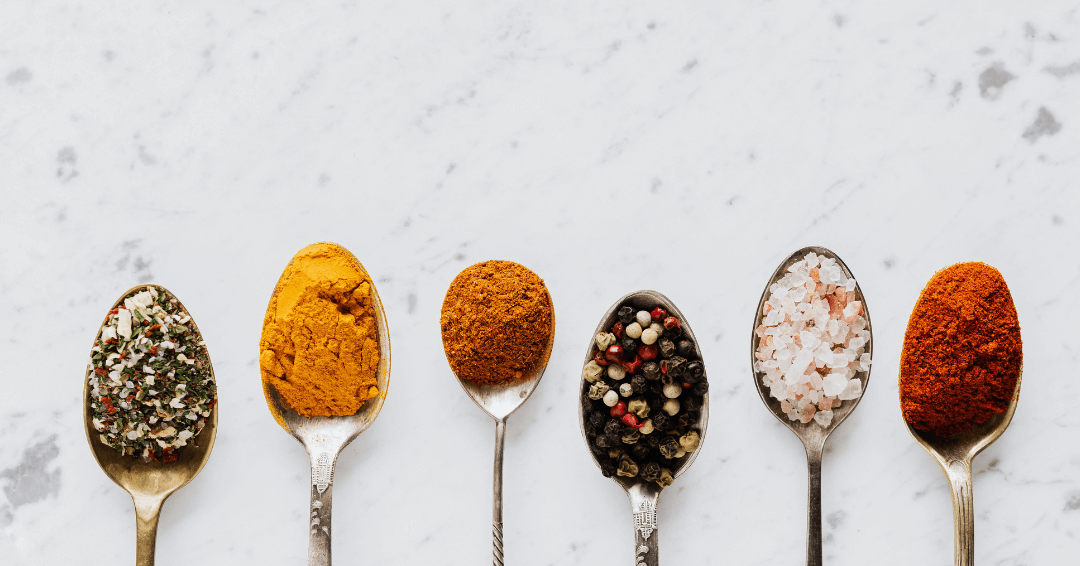
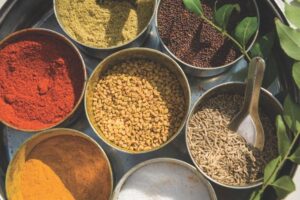 It’s Hispanic Heritage Month, and we’ve been celebrating with the best tool we have: food!
It’s Hispanic Heritage Month, and we’ve been celebrating with the best tool we have: food!
The Latin American Heritage Diet promotes richly flavorful, affordable and easy-to-prepare foods – it’s a way of eating that can find a place in your kitchen even after Hispanic Heritage Month comes to an end on October 15. This diet reflects a wide range of fantastic culinary traditions, nutrition, and flavors: many of which begin with herbs and spices.
The terms “herb” and “spice” both describe parts of plants (dried or fresh) that are used to enhance the flavor of foods and are often the heart of unique heritage dishes. Spices come from the bark, roots, seeds, or fruits of a plant, while herbs come from the green, leafy parts of a plant. Herbs and spices are a delicious way to bump up the flavor – and nutrition — of a dish without relying on the salt shaker.
There are so many herbs and spices that you can start incorporating into your kitchen to enjoy the flavors of Latin America – here are a few starting points and corresponding meal ideas…
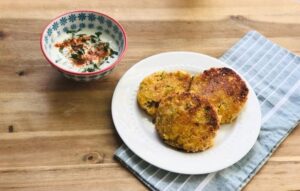 Cilantro: Cilantro has a bright, robust flavor that makes it the most popular fresh herb in the world. To enjoy the full flavor of cilantro, use the leaves as a garnish or stir them into salads, salsas, and dips. Some people think cilantro tastes “soapy;” culture and genetics may both play a role in this. If you’re not already a cilantro lover, start by mixing small amounts into dishes and going from there.
Cilantro: Cilantro has a bright, robust flavor that makes it the most popular fresh herb in the world. To enjoy the full flavor of cilantro, use the leaves as a garnish or stir them into salads, salsas, and dips. Some people think cilantro tastes “soapy;” culture and genetics may both play a role in this. If you’re not already a cilantro lover, start by mixing small amounts into dishes and going from there.
These Jalapeño Corn Salmon Patties with Cilantro Lime Sauce are a delicious meld of many Latin American flavors – including lime, corn and jalapeño – but the cilantro adds that special, bright touch to the sauce.
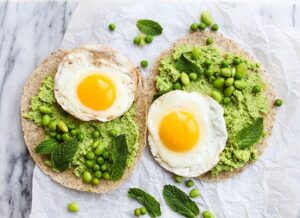 Mint: This delicious herb is native to present-day Mexico and Central America, where several varieties were used by the Mayans and the Aztecs for medicinal and culinary purposes. Mint’s refreshing flavor and cooling sensation make it a great ingredient to use in drinks and desserts.
Mint: This delicious herb is native to present-day Mexico and Central America, where several varieties were used by the Mayans and the Aztecs for medicinal and culinary purposes. Mint’s refreshing flavor and cooling sensation make it a great ingredient to use in drinks and desserts.
However, mint can fit perfectly into savory dishes, too. Try these Edamame, Sweet Pea and Egg Breakfast Tortillas – spread across a whole wheat pita, the edamame-mint “hummus” contrasts beautifully with the eggs on top.
 Cumin: Cumin is popular in almost all Latin American countries. This versatile spice lends its warm, earthy flavor to dishes like sopa de frijol negro (a Cuban black bean soup), merkén (a Chilean spice blend), and refrito (an Ecuadorian version of sofrito).
Cumin: Cumin is popular in almost all Latin American countries. This versatile spice lends its warm, earthy flavor to dishes like sopa de frijol negro (a Cuban black bean soup), merkén (a Chilean spice blend), and refrito (an Ecuadorian version of sofrito).
Try these Crispy Fish Tacos – you’ll get a double-dose of heritage herbs and spices with the cumin and cilantro yogurt sauce.
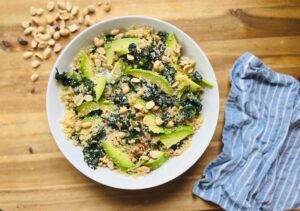
Red pepper flakes: These little pockets of heat are made from a variety of dried and crushed chile peppers. A small amount adds a lot of spice, so add a little bit at a time to beans, soups, and stews. It can also be used as a substitute for chile powder, which is made from dried chile peppers that have been ground instead of crushed.
In this Peanut Quinoa Salad with Chard and Avocado, featuring traditional Latin American ingredients, the creaminess of the avocado is balanced by the crunch of the peanuts, creating a delightful contrast of textures and flavors. Red pepper flakes add spice to this hearty grain salad.
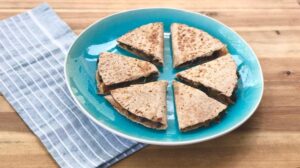 Chili powder: Not to be confused with chile powder (or your dish will be extremely spicy!) chili powder is a blend of ground spices, chile pepper mixed with black pepper, cumin, garlic, and oregano. Make it yourself to customize the flavor, or find pre-made mixes at the grocery store.
Chili powder: Not to be confused with chile powder (or your dish will be extremely spicy!) chili powder is a blend of ground spices, chile pepper mixed with black pepper, cumin, garlic, and oregano. Make it yourself to customize the flavor, or find pre-made mixes at the grocery store.
Quesadillas are one of those crowd-pleasing dishes that satisfy adults and kids alike. In these Black Bean and Poblano Quesadillas with Caramelized Onions, we remove the seeds from the poblano peppers to cut down on the spiciness. Chili powder and black beans add a hearty warmth to this savory dish.
 Mexican oregano: This is a warm, slightly bitter spice. It is very popular in Latin American cooking and pairs well with chile peppers and tomato-based dishes. Look for bottles specifically labeled “Mexican oregano,” or try dried marjoram as a substitute. Mexican oregano is not the same plant as Mediterranean oregano; it has a stronger, more citrusy flavor.
Mexican oregano: This is a warm, slightly bitter spice. It is very popular in Latin American cooking and pairs well with chile peppers and tomato-based dishes. Look for bottles specifically labeled “Mexican oregano,” or try dried marjoram as a substitute. Mexican oregano is not the same plant as Mediterranean oregano; it has a stronger, more citrusy flavor.
As a meatless main or a savory side, these Quinoa-Stuffed Peppers are as pleasing to your tastebuds as they are pretty on the plate. Although it calls for marjoram, Mexican oregano would be the perfect replacement.
Finally, although it’s not an herb or spice, sofrito is another seasoning staple in Latin American cooking. To make it, ingredients are finely chopped and sautéed in oil to create a flavorful base for a dish. Onions, garlic, peppers and tomatoes are all common ingredients, but the recipe varies widely from country to country, and from cook to cook. Simmering the sofrito slowly, over a longer period of time, and including an onion in the recipe are not just important for the development of flavor — researchers found that these steps actually improve the antioxidant capacity and bioavailability of the lycopene, a healthy plant compound found in tomatoes.
Browse Oldways’ recipe collection to bring the flavors of the Latin American Heritage Diet into your own home kitchen, or, for a fully immersive experience into the diet’s rich background, become a student or instructor in our A Taste of Latin American Heritage course – a six-lesson nutrition and cooking program.
Want biweekly Heritage Diet information and recipes in your Inbox? Sign up for our Fresh Fridays newsletter at the bottom of this page!





Leave a comment